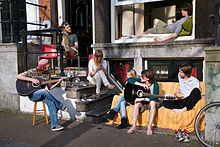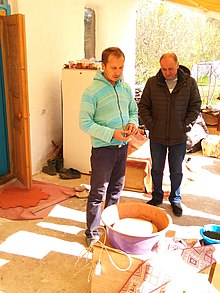An intentional community is a voluntary residential community which is designed to have a high degree of social cohesion and teamwork.[1][2][3] The members of an intentional community typically hold a common social, political, religious, or spiritual vision, and typically share responsibilities and property. This way of life is sometimes characterized as an “alternative lifestyle“.[4] Intentional communities can be seen as social experiments or communal experiments.[1][5] The multitude of intentional communities includes collective households, cohousing communities, coliving, ecovillages, monasteries, survivalist retreats, kibbutzim, Hutterites, ashrams, and housing cooperatives.




Ashrams
Ashrams are likely the earliest intentional communities, founded around 1500 BCE. Buddhist monasteries appeared around 500 BCE.[6] Pythagoras founded an intellectual vegetarian commune in about 525 BCE in southern Italy.[7] Hundreds of modern intentional communities were formed across Europe, North and South America, Australia, and New Zealand out of the intellectual foment of utopianism.[7] Intentional communities exhibit the utopian ambition to create a better, more sustainable world for living.[7] Nevertheless, the term utopian community as a synonym for an intentional community might be considered to be of pejorative nature and many intentional communities do not consider themselves to be utopian.[1] Also the alternative term commune[a] is considered to be non-neutral or even linked to leftist politics or hippies.[9][10][11]
Synonyms and definitions
Additional terms referring to an intentional community can be alternative lifestyle, intentional society, cooperative community, withdrawn community, enacted community, socialist colony, communistic society, collective settlement, communal society, commune, mutualistic community, communitarian experiment, experimental community, utopian experiment, practical utopia, and utopian society.[12]
| Authorship | Year | Definition |
|---|---|---|
| B. Shenker | 1986 | “An intentional community is a relatively small group of people who have created a whole way of life for the attainment of a certain set of goals.”[1] |
| D. E. Pitzer | 1989 | Intentional communities are “small, voluntary social units partly isolated from the general society in which members share an economic union and lifestyle in an attempt to implement, at least in part, their ideal ideological, religious, political, social, economic, and educational systems”.[2] |
| G. Kozeny | 1996 | “An ‘intentional community’ is a group of people who have chosen to live together with a common purpose, working cooperatively to create a lifestyle that reflects their shared core values. The people may live together on a piece of rural land, in a suburban home, or in an urban neighborhood, and they may share a single residence or live in a cluster of dwellings.”[13] |
| W. J. Metcalf | 2004 | An intentional community is “[f]ive or more people, drawn from more than one family or kinship group, who have voluntarily come together for the purpose of ameliorating perceived social problems and inadequacies. They seek to live beyond the bounds of mainstream society by adopting a consciously devised and usually well thought-out social and cultural alternative. In the pursuit of their goals, they share significant aspects of their lives together. Participants are characterized by a “we-consciousness,” seeing themselves as a continuing group, separate from and in many ways better than the society from which they emerged.”[3] |
Purposes
The purposes of intentional communities vary and may be political, spiritual, economic, or environmental.[14] In addition to spiritual communities, secular communities also exist.[15] One common practice, particularly in spiritual communities, is communal meals.[16] Egalitarian values can be combined with other values.[17] Benjamin Zablocki categorized communities this way:[18]
- Academic communities (see Living-Learning Communities)
- Alternative-family communities (see Tenacious Unicorn Ranch)
- Coliving communities
- Cooperative communities
- Countercultural communities
- Egalitarian communities
- Experimental communities
- Political communities
- Psychological communities (based on mystical or gestalt principles)
- Rehabilitational communities (see Synanon)
- Religious communities
- Spiritual communities